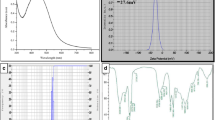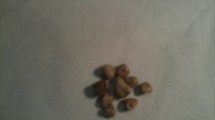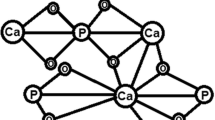Abstract
Plant bio constituents have the ability to prepare nanoparticles, and usually, plant polyphenols are tested to reduce sodium selenite to selenium nanoparticles (SeNPs). In this work, we showed the biosynthesis of SeNPs using Ocimum tenuiflorum leaf extract. The as obtained SeNPs were in the size range of 15–20 nm and spherical in shape. Also, TEM microscopic images represented the aggregation of crystal structures as extracellular deposits. Moreover, scanning electron microscopy was performed to examine the chemical transition of calcium oxalate (CaC2O4) crystal’s shape and structure due to the influence of SeNPs. SeNPs inhibited the aggregation and growth of CaC2O4 monohydrate crystals and hence the prepared SeNPs could have important prospects in medical and pharmaceutical applications as a potential inhibitor of CaC2O4 urinary stones.







Similar content being viewed by others
References
Clement IP (1998) Lessons from basic research in selenium and cancer prevention. J Nutr 128:1845–1854
Cremonini E, Zonaro E, Donini M, Lampis S, Boaretti M, Dusi S, Melotti P, Lleo MM, Vallini G (2016) Biogenic selenium nanoparticles: characterization, antimicrobial activity and effects on human dendritic cells and fibroblasts. Microb Biotechnol 9:758–771
Cui D, Yan C, Miao J, Zhang X, Chen J, Sun L, Meng L, Liang T, Li Q (2018) Synthesis, characterization and antitumor properties of selenium nanoparticles coupling with ferulic acid. Mater Sci Eng 90:104–112
Dhanjal S, Cameotra SS (2010) Aerobic biogenesis of selenium nanospheres by Bacillus cereus isolated from coalmine soil. Microb Cell Fact 9:52–62
Ganesan V (2015) Biogenic synthesis and characterization of selenium nanoparticles using the flower of Bougainvillea spectabilis Willd. Int J Sci Res 4:690–695
Gautam PK, Kumar S, Tomar MS, Singh RK, Acharya A, Kumar S, Ram B (2017) Selenium nanoparticles induce suppressed function of tumor associated macrophages and inhibit Dalton’s lymphoma proliferation. Biochem Biophys Rep 12:172–184
Husen A, Siddiqi KS (2014) Plants and microbes assisted selenium nanoparticles: characterization and application. J Nanobiotechnol 12:1–10
Johnson JA, Saboungi M-L, Thiyagarajan P, Csencsits R, Meisel D (1999) Selenium nanoparticles: a small-angle neutron scattering study. J Phys Chem B 103:59–63
Knekt P, Marniemi J, Teppo L, Heliovaara M, Aromaa A (1998) Is low selenium status a risk factor for lung cancer. Am J Epidemiol 148:975–982
Li Q, Chen T, Yang F, Liu J, Zheng W (2010) Facile and controllable one-step fabrication of selenium nanoparticles assisted by l-cysteine. Mater Lett 64:614–617
Rayman MP (2000) The importance of selenium to human health. Lancet 356:233–241
Rayman MP (2005) Selenium in cancer prevention: a review of the evidence and mechanism of action. Proc Nutr Soc 64:527–542
Shin Y, Blackwood JM, Bae I, Arey BW, Exarhos GJ (2007) Synthesis and stabilization of selenium nanoparticles on cellulose nanocrystals. Mater Lett 61:4297–4300
Sireesh Babu M (2017) Green synthesis of biocompatible Au–Cu2–xSe heterodimer nanoparticles and their in vitro photothermal assay. Environ Toxicol Pharmacol 53:29–33
Sireesh Babu M, Badal Kumar M, Shivendu R, Nandita D (2015) Diastase assisted green synthesis of size controllable gold nanoparticles. RSC Adv 5:26727–26733
Sireesh Babu M, Badal Kumar M, Kiran Kumar A (2017a) Environment friendly approach for size controllable synthesis of biocompatible silver nanoparticles using diastase. Environ Toxicol Pharmacol 49:131–136
Sireesh Babu M, Badal Kumar M, Kiran Kumar A (2017b) Tyrosine assisted size controlled synthesis of silver nanoparticles and their catalytic and in vitro cytotoxicity evaluation. Environ Toxicol Pharmacol 51:23–29
Sireesh Babu M, Jegatheeswaran S, Serap SuzuK Y, Guobin H, Yurong C, Junkuo G, Qingqing N, Yao Juming (2018) Silk sericin induced fabrication of reduced graphene oxide and its in vitro cytotoxicity, photothermal evaluation. J Photochem Photobiol B 186:189–196
Sofer Z, Bartůněk V, Junková J, Ulbrich P, Babuněk M, Kuchař M (2016) Synthesis of spherical amorphous selenium nano and microparticles with tunable sizes. Micro Nano Lett 11:91–93
Srivastava P, Kowshik M (2016) Anti-neoplastic selenium nanoparticles from Idiomarina sp. PR58-8. Enzyme Microb Technol 95:192–200
Stuke J, Zingaro RA, Cooper WC (1974) Selenium. Van Nostrand Reinhold, New York, p 177
Wang T, Yang L, Zhang B, Liu J (2010) Extracellular biosynthesis and transformation of selenium nanoparticles and application in H2O2 biosensor. Colloids Surf B 80:94–102
Xia YY (2007) Synthesis of selenium nanoparticles in the presence of silk fibronin. Mater Lett 61:4321–4324
Yu B, Liu T, Du Y, Luo Z, Zheng W, Chen T (2016a) X-ray-responsive selenium nanoparticles for enhanced cancer chemo-radiotherapy. Colloids Surf B 139:180–189
Yu B, You P, Song M, Zhou Y, Yu F, Zheng W (2016b) A facile and fast synthetic approach to create selenium nanoparticles with diverse shapes and their antioxidation ability. New J Chem 40:1118–1123
Zeng H, Combs GF (2008) Selenium as an anticancer nutrient: roles in cell proliferation and tumor cell invasion. J Nutr Biochem 19:1–7
Zhang W, Chen Z, Liu H, Zhang L, Gao P, Li D (2011) Biosynthesis and structural characteristics of selenium nanoparticles by Pseudomonas alcaliphila. Colloids Surf B 88:196–201
Acknowledgements
This work was funded by characteristic specialty, Shanghai Sixth People’s Hospital East Affiliated to Shanghai University of Medicine & Health Sciences (No. 2017022).
Author information
Authors and Affiliations
Corresponding author
Rights and permissions
About this article
Cite this article
Liang, T., Qiu, X., Ye, X. et al. Biosynthesis of selenium nanoparticles and their effect on changes in urinary nanocrystallites in calcium oxalate stone formation. 3 Biotech 10, 23 (2020). https://doi.org/10.1007/s13205-019-1999-7
Received:
Accepted:
Published:
DOI: https://doi.org/10.1007/s13205-019-1999-7




